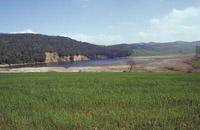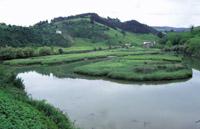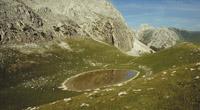Interior karst wetlands of the Basque Country (VII)
2000/11/01 Estonba Mintxero, Mikel Iturria: Elhuyar aldizkaria
As the calcium carbonate of the limestone and the calcium sulfate of the plaster dissolve with water, in the geological formations dominated by this type of rock, through the process called karstification, the interior is filled with tubes and perforations. Along these underground paths the water moves at high speed and while moving continues with the dissolution of stones, the increase of the channels and the salt load. The process leaves indications on the terrestrial surface of funnel-shaped drains, known as dolinas, springs, cencerros, simas, osinas, etc. that appear in unexpected places. Many of the wetlands, lagoons and ponds of the Basque Country have been created through karstification processes.
The decalcification clays that leave the limestones dissolved as remains have been formed when the backgrounds of the dolinas are waterproofed. If the dolinas that host these wetlands are originated in the highlands of the sierras by dissolution of limestone (dissolution dolinas), normally the wetlands are supplied only with runoff water, they are usually of very small size and their margins are not very abrupt. If the dolinas are a consequence of the erosion of groundwater, the fall of the upper layers (collapses), in addition to having greater depth and steeper edges, they are wetlands normally provided with groundwater.
In limestone regions, even where water comes out of the subsoil, as a result of dissolution, depressions may appear. Once these depressions are filled with the mentioned water, karst ponds or lagoons can develop. They are also karst wetlands associated with rivers that cross limestone areas. In these cases, while the dissolution increases the depth of the channel, the precipitation of the dissolved carbonates can form diocesan accumulations (tobas) and along the valleys many karstic lagoons appear below.
However, other karst wetlands appear in depressions that form in geological structures called diapiro. The diapiros are geological structures in the form of cupola constituted mainly by plaster, marl and clays of the Triassic. Due to the high plasticity and low density of these materials, they drill or climb geological layers of tertiary type. As a result, older materials appear alongside younger or older materials on young people. In this way geological structures are formed really curious. The stones that form the fingerboards are soft and easily erosionable. Therefore, in zones with diapiros, depressions are usually created. In most cases, these depressions cut the groundwater levels of the area and emerge, leading to the emergence of ponds and sometimes lakes. Due to the characteristics of these geological structures, they often appear associated with salt springs, so many of the salt mines that are exploited in the Basque Country or that have been exploited at times are located in places where the diapiros appear (for example, the salt flats of Salinas de Añana de Álava or the salt flats of Jaitz or Arteta de Navarra).
Both wetlands that only receive runoff water and those that receive groundwater have oligotrophic waters. In the former, the water runs very short routes before reaching the wetland, which causes the water to have few mineral nutrients. In the latter, however, after crossing soluble stones under the soil, the waters reach the wetland quite mineralized. Carbonates, sulphates, calcium and magnesium abound in this type of water. Chloride and sodium appear in a smaller proportion. However, in these cases, the abundance of calcium not only causes water to be alkaline, but also precipitates phosphorus, so they usually contain transparent waters of low production, oxygenated, cold and oligotrophic.
Despite being low production environments, they sometimes have a high degree of organization and complexity, especially those with deep water and underground flows, where we find isolated and surprising communities of means and living beings. Among them are the communities of prokaryotes capable of performing photosynthesis without oxygen, which inhabit deep waters rich in plaster. They are living witnesses of the early stages of life history. However, the object of this work is the wet areas and the deep water areas cannot be recognized as wet areas, so it will not delve further into this aspect and will be considered only the humid areas that are usually developed at the margins of deep water systems.
Vegetation
The diversity of geological origins of karst wetlands makes there exist numerous examples of depths, dimensions, aspect of the bucket and inclination of their very different margins. To this geological diversity we must add the climate diversity that we find in Euskal Herria, being located between the Euro-Siberian and Mediterranean bioclimatic region, with a remarkable difference in altitude and with relatively different weather conditions in small sections. Apart from the diversity of vegetation associated with the numerous climatic conditions, in karst wetlands with shallow margins and steep slopes aquatic vegetation predominates, while in those with deep margins but with soft slopes, the most important vegetation is that of reeds and reeds. Between these two types of models there are many intermediate examples. As for vegetation, it can be said that in the Basque Country the karst wetlands associated with the diapiros are richer. The rest, in addition to being smaller, are normally close to the mountains, which forces them to withstand more severe weather conditions, which directly affects local plant and animal communities.
In aquatic plants are frequent vascular species Pomatogeton coloratus, Miriophyllum verticilatum, Elodea canadensis, Dense Greenland or Ceratophyllum demersum. Also abundant are the carotid algae of the genera Chara and Nitella.
In cases where the slope of the edges is low, reeds are formed. When these reeds extend widely in wetlands, two main areas can be distinguished: the interior of the reed that develops at greater depth of water and the exterior of the reed that appears at low depth. In the first, the most abundant plants are Cladium mariscus and Scirpus lacustris, while in the second predominate Phragmatis australis and Tipha angustifolia.
Behind the reeds, in areas where soil moisture is high without being submerged, juncals usually appear formed by species of the genera Scirpus and Juncus.
Wildlife
Due to the abundance of karst wetlands and the different weather conditions in the regions where they appear, it is very difficult to talk about wildlife in general.
On the one hand, it should be noted that the steep edges found in most of these wetlands significantly limit the possibility of living benthic communities. Among those modelled to live in these conditions are species of crustaceans, molluscs, nematodes and oligochetes, as well as larvae of different species of insects. Due to its high concentrations, the Unio pictorum bivalvo stands out. Because there you have no problem in getting the calcium you need to build the shell.
On the shores, however, the fauna is richer. To the thriving communities of invertebrates composed of several insects, molluscs and crustaceans must be added an important representation of amphibians. Among the invertebrates are the amphipod Gammarus pungens and the decapod Atyaephyra desmarestii. As for amphibians, numerous species of amphibians can be observed in karst wetlands scattered throughout the geography of the Basque Country, especially during the reproductive period, in which all amphibians are directed to water.
Among the amphibians that we can find in our karst wetlands are pale triton, marmolaire triton, common harlot, common frog, red wild frog, agile frog, agile frog, common tree frog, txantxikua, painted toad, common toad, corridor toad...
As for the ornithophan, low nutrient concentrations and the small size of most wetlands, as well as margins without dense vegetation, do not exist an abundant community of birds. However, in areas with large water surfaces and compact, structured reeds, it is not difficult to observe some species of birds adapted to live in aquatic ecosystems. Migratory species in most cases
are priests but can be assured that they nest in some karst wetlands. In open waters are frequent analogies (ducks, fences, divers), podizipediformes (batons and heath) and rashes, as flirtatious. However, in the carrizales of the banks they inhabit rashes like carrizales, benarrignos, verduritas of marsh or water hens and water hens.

Gai honi buruzko eduki gehiago
Elhuyarrek garatutako teknologia





